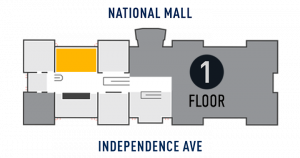This engine powered the last generation of piston engine transports, including the Douglas DC-7 and Lockheed Super Constellation. It represents the end of engine-development that began with the famous Wright Whirlwind, and included an entire family of military and commercial piston power plants. The somewhat unique feature of this engine was a turbo compound device, consisting of an exhaust-driven turbine geared to the crankshaft, generating 20 percent additional take-off power without increasing fuel consumption.
The Wright R-3350 Turbo-Cyclone 18 also powered the following aircraft types: Lockheed P2V-7 Neptune patrol bomber, Martin P5M-1 and -2 Marlin patrol flying boat, Fairchild C-119F and G Packet troop and cargo transport, Lockheed C-121 transport, and Canadair CL-28 maritime reconnaissance.
This artifact powered the American Airlines Douglas DC-7C "Flagship Vermont." A total of 374 engines of this model were built between August 1952 and December 1954. A total of 5,656 commercial C18 and 44,536 military R-3350 engines were manufactured.
Display Status
This object is on display in America by Air at the National Air and Space Museum in Washington, DC.

Object Details
Key Accomplishment(s)
Powered Last Generation of Piston Engine Transports
Brief Description
This engine powered the last generation of piston engine transports, including the Douglas DC-7 and Lockheed Super Constellation. A turbo compound device generated 20% more take-off power without increasing fuel consumption.
Date
1952
Country of Origin
United States of America
Type
PROPULSION-Reciprocating & Rotary
Manufacturer
Wright Aeronautical
Physical Description
Type: Reciprocating, 18 cylinders, 2 rows, radial, air-cooled
Power rating: 2,424 kW (3,250 hp) at 2,900 rpm
Displacement: 54.9 L (3,350 cu in.)
Bore and Stroke: 156 mm (6.1 in.) x 160 mm (6.3 in.)
Weight: 1621 kg (3573 lb)
Dimensions
3-D: 233.2 × 143.8cm, 1620.7kg (91 13/16 × 56 5/8 in., 3573lb.)
Support: 280.7 × 158.8 × 188.6cm (110 1/2 in. × 62 1/2 in. × 74 1/4 in.)
Materials
Engine Overall - Steel, Aluminum, Inconel X
Alternate Name
Wright Turbo-Cyclone 18R-3350-TC Radial Engine
Inventory Number
A19660150000
Credit Line
Gift of American Airlines, Inc.
Data Source
National Air and Space Museum
Restrictions & Rights
Open Access (CCO)
For more information, visit the Smithsonian’s Terms of Use.